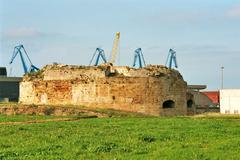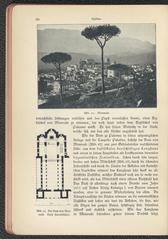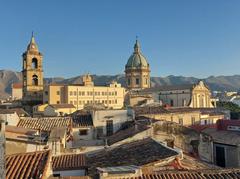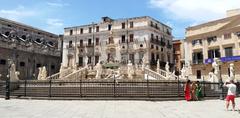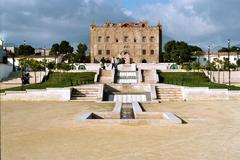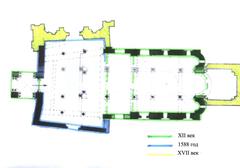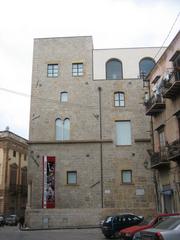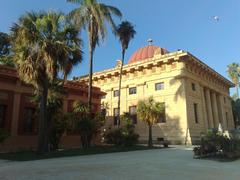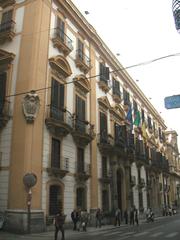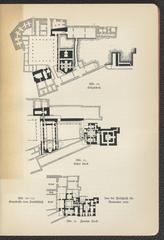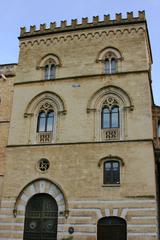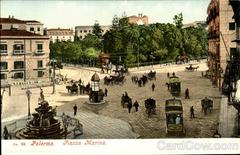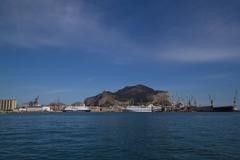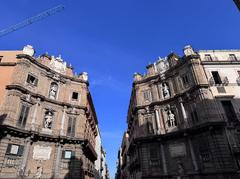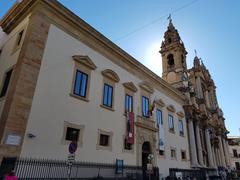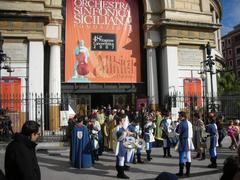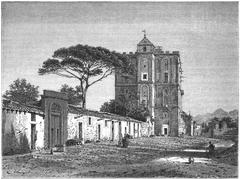
Visiting Ponte dell’Ammiraglio: History, Tips, and Visitor Information
Date: 19/07/2024
Introduction
The Ponte dell’Ammiraglio, or Admiral’s Bridge, stands as one of Palermo’s most treasured historical landmarks, offering a window into the rich tapestry of Sicily’s past. Constructed in the 12th century during the reign of Roger II of Sicily, the bridge was commissioned by George of Antioch, the admiral of the fleet. This period marked a significant cultural and political transformation in Sicily, blending Norman, Arab, and Byzantine influences, which is vividly reflected in the bridge’s architectural design (UNESCO World Heritage List). Featuring twelve pointed arches made of local limestone, the Ponte dell’Ammiraglio showcases the advanced engineering techniques of the medieval era, serving as a crucial infrastructure element that facilitated trade and communication across the Oreto River. Its historical significance is further underscored by the Battle of the Bridge in 1860, a key event in the Italian unification movement led by Giuseppe Garibaldi. Today, the bridge not only stands as a testament to medieval craftsmanship but also as a symbol of Palermo’s diverse cultural heritage, attracting tourists and history enthusiasts from around the world.
Table of Contents
- [History of Ponte dell’Ammiraglio](#history-of-ponte-dellammiragliohistory-of-ponte-dellammiraglio)
- [Origins and Construction](#origins-and-constructionorigins-and-construction)
- [Architectural Significance](#architectural-significancearchitectural-significance)
- [Historical Context](#historical-contexthistorical-context)
- [Role in Medieval Palermo](#role-in-medieval-palermorole-in-medieval-palermo)
- [The Battle of the Bridge](#the-battle-of-the-bridgethe-battle-of-the-bridge)
- [Preservation and Restoration](#preservation-and-restorationpreservation-and-restoration)
- [UNESCO World Heritage Site](#unesco-world-heritage-siteunesco-world-heritage-site)
- [Visitor Information](#visitor-informationvisitor-information)
- [Visiting Hours](#visiting-hoursvisiting-hours)
- [Ticket Prices](#ticket-pricesticket-prices)
- [Accessibility](#accessibilityaccessibility)
- [Travel Tips](#travel-tipstravel-tips)
- [Nearby Attractions](#nearby-attractionsnearby-attractions)
- [Special Events](#special-eventsspecial-events)
- [Guided Tours](#guided-toursguided-tours)
- [Photographic Spots](#photographic-spotsphotographic-spots)
- [Modern-Day Relevance](#modern-day-relevancemodern-day-relevance)
- [FAQ](#faqfaq)
- [Conclusion](#conclusionconclusion)
- [References](#referencesreferences)
History of Ponte dell’Ammiraglio
Origins and Construction
The Ponte dell’Ammiraglio, or Admiral’s Bridge, is a historic stone bridge located in Palermo, Italy. Its construction dates back to the 12th century, specifically around 1131-1133, during the reign of Roger II of Sicily. The bridge was commissioned by George of Antioch, the admiral of the fleet. George of Antioch was a prominent figure in the Norman court, and his influence is evident in the architectural style of the bridge, which combines Norman and Arab elements.
Architectural Significance
The bridge is an exemplary piece of medieval engineering, showcasing the advanced construction techniques of the time. It spans the Oreto River with twelve arches, each designed to withstand the river’s flow and potential flooding. The use of pointed arches is particularly notable, as this design was relatively innovative for the period and provided greater structural stability. The bridge’s construction utilized local limestone, which has contributed to its durability over the centuries.
Historical Context
The Ponte dell’Ammiraglio was built during a period of significant cultural and political transformation in Sicily. The island was under Norman rule, having been conquered from the Arabs in the late 11th century. The Normans, originally from Northern France, brought with them their architectural styles and techniques, which they blended with the existing Arab and Byzantine influences in Sicily. This fusion of styles is evident in the design of the bridge.
Role in Medieval Palermo
During the medieval period, the Ponte dell’Ammiraglio played a crucial role in the infrastructure of Palermo. It served as a vital crossing point over the Oreto River, facilitating trade and communication between the city and its surrounding areas. The bridge was part of a larger network of roads and bridges that connected Palermo to other important cities and regions in Sicily.
The Battle of the Bridge
One of the most significant historical events associated with the Ponte dell’Ammiraglio is the Battle of the Bridge, which took place on January 27, 1860. This battle was a key moment in the Italian unification movement, known as the Risorgimento. Giuseppe Garibaldi, a leading figure in the movement, led his forces against the Bourbon troops at the bridge. The victory at this battle was instrumental in the eventual unification of Italy. The bridge thus holds not only architectural but also symbolic significance in Italian history.
Preservation and Restoration
Over the centuries, the Ponte dell’Ammiraglio has undergone various restoration efforts to preserve its structural integrity and historical value. In the 19th century, significant repairs were made to address damage caused by natural wear and tear as well as human activity. More recently, in the 20th and 21st centuries, conservation efforts have focused on maintaining the bridge’s original materials and design while ensuring its stability for future generations.
UNESCO World Heritage Site
In 2015, the Ponte dell’Ammiraglio was designated as a UNESCO World Heritage Site as part of the Arab-Norman Palermo and the Cathedral Churches of Cefalù and Monreale (UNESCO World Heritage List). This recognition highlights the bridge’s importance as a cultural and historical landmark, reflecting the rich and diverse heritage of Sicily. The UNESCO designation has also helped to promote further preservation efforts and increase awareness of the bridge’s significance.
Visitor Information
Visiting Hours
- Opening Hours: The bridge is accessible 24/7. However, guided tours are available from 9 AM to 5 PM.
Ticket Prices
- Admission: Free. Guided tours may have a fee.
Accessibility
- Accessibility: The bridge is accessible to pedestrians and offers wheelchair access.
Travel Tips
- Best Time to Visit: Early morning or late afternoon for the best lighting and fewer crowds.
Nearby Attractions
- Nearby Attractions: The Botanical Garden, Kalsa District, Palermo Cathedral.
Special Events
- Events: Check the official website for information on special events and guided tours.
Guided Tours
- Tours: Available daily. Book in advance for a more personalized experience.
Photographic Spots
- Photo Tips: The best spots for photography are from the north bank of the Oreto River.
Modern-Day Relevance
Today, the Ponte dell’Ammiraglio stands as a testament to the ingenuity and craftsmanship of medieval builders. It continues to attract tourists and history enthusiasts from around the world, who come to admire its architectural beauty and learn about its storied past. The bridge is not only a historical monument but also a symbol of the cultural synthesis that characterizes Sicily’s history.
FAQ
Q - What are the visiting hours for Ponte dell’Ammiraglio?
A - The bridge is accessible 24/7, with guided tours available from 9 AM to 5 PM.
Q - Is there an entrance fee to visit the bridge?
A - No, visiting the bridge is free. Guided tours may have a fee.
Conclusion
In conclusion, the Ponte dell’Ammiraglio is not merely a bridge but a monumental piece of Palermo’s history and heritage. Its construction during the Norman period signifies a blend of various cultural influences that have shaped Sicily. Designated as a UNESCO World Heritage Site in 2015, the bridge highlights the ingenuity and craftsmanship of medieval engineers (UNESCO World Heritage List). Accessible to visitors 24/7 with no entrance fee, it offers a unique glimpse into the medieval past of Palermo, making it a must-visit landmark for anyone interested in history and architecture. Guided tours provide deeper insights, enhancing the visitor experience, while nearby attractions like the Botanical Garden and the Kalsa District further enrich the cultural journey. Preservation efforts continue to maintain its structural integrity and historical authenticity, ensuring that future generations can also marvel at this architectural gem. For more detailed information and updates, visitors are encouraged to download the mobile app Audiala, check out related posts, or follow on social media.
References
- UNESCO World Heritage List, 2024, UNESCO source url




